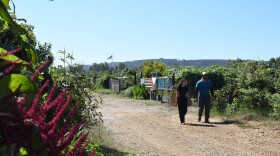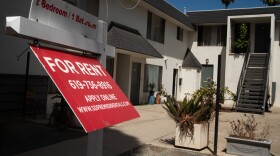Speaker 1: (00:00)
A pair of recent Navy reports, point to multiple failures in the July, 2020 fire that destroyed the USS bottom. Rashard at Navy base San Diego. The contents of the reports were the subject of a Navy press conference this morning, which found that as smoke billowed in the air for five days, failed equipment and training stood in the way of extinguishing the flames. Joining us with details on the report is KPBS military reporter Steve Walsh, Steve. Welcome.
Speaker 2: (00:30)
Hi Jared. There was not only a report that came out today, uh, or rather a press conference, but, um, but there were two reports that came out today that really looked at, uh, the, not just what happened on the day of the fire, but, uh, looked at historically at Navy fires, dating all the way back to 2008.
Speaker 1: (00:51)
So without getting into the full findings of recent reports, can you summarize what conclusions were made?
Speaker 2: (00:57)
So what they found is that there were, the Navy had several, a systemic failures here that they're vulnerable to inside threats, like, like arson, Admiral bill, a lesser. It was the vice chief of Naval operations says that despite the Navy's assertion, that this was arson, he sees that the loss of the bottom or shard as preventable and wholly unacceptable, he said there were, there were just a series of failures. The entities didn't cooperate. There was the, just both reports pointed this situation where there was just chaos. The day of the fire, you had several sailors going into investigate and seeing a fire and then coming back and reporting rather than actually grabbing equipment and trying to fight the fire. Uh, the ne the Navy says that, uh, the equipment on board, the USS Bon number shard that was there to fight fires was never actually used.
Speaker 2: (01:51)
Um, they did that. The sailors didn't understand a sprinkler system that was there on board and, and how that was, how that could have helped. Now they w this, the bottom Rashard was in, uh, was in San Diego for an extended maintenance period. So not, they didn't have a full crew on board. They only had about 138 sailors out of a 1000 crew members that are normally on board. The USO is Bonham Rashard. Um, one of the admirals, um, uh, Scott Kahn said that, um, the Navy is really good at fighting fires at sea. When you have a full compliment, everybody is drilled up and trained. They have all of their equipment and all the command in place, but it's during these times of transitions where they're in, in dock in port and not everybody's a board, this is when they've seen, not just at this time, but, but a series of fires happen all the way dating back to 2008. Hm.
Speaker 1: (02:46)
Now you re, you went through the widespread failures and protocols and equipment, uh, but besides the initial act of arson, does the report place more blame with the rank and file troops or the commanding officers in charge?
Speaker 2: (03:00)
Well, it's all the way down the line. I mean, the report points to things such as, um, the commanders on board, the USS Bonham Rashard, didn't even call in the fire, uh, and call in firefighters. It was a dispatcher who was monitoring the radio chatter of the USS bottom. We started and heard some talk of fire, and the dispatcher was the person who actually called the fire department there. And then once the firefighters arrived, nobody led them to the fire or even showed them the best way to get inside the ship, which created a whole series of delays. Uh, it took them upwards of an hour to really sort of start to get their act together. And by that time, the fire had really started to spread, but I mean, the failures just keep, keep going. Um, at one point, um, the report says that, um, commanders on the ground Naval commanders, uh, were frustrated that the San Diego fire department, wasn't going back into the ship to try to fight the fires. They didn't feel it was safe. And they told them if they weren't going to go in, they could leave. And apparently for the, for a time, uh, San Diego firefighters did pull out and they left, which of course just did nothing more than to create, uh, more delays in this fire, into the burning pier side for, for almost five days
Speaker 1: (04:19)
And the fire suppression system on, on the ship, wasn't working
Speaker 2: (04:23)
Parts of it. Parts of it were not working parts of it. We're not a well-maintained they, um, parts of it were disabled because of, uh, because of the maintenance, but on top of all of that, even the systems that were working and were available to sailors, they weren't used because people were not adequately trained
Speaker 1: (04:43)
Reports of the fire were found to be falsified. How so?
Speaker 2: (04:48)
Um, well, I believe what you're referring to is that, um, some of the, um, fire equipment was, was listed as, uh, as working when in fact it had not been tested, uh, it had been signed off on, even though it had not been working at the time.
Speaker 1: (05:05)
So what kind of disciplinary action can be expected moving forward?
Speaker 2: (05:09)
So we already have, of course, uh, semen rhyme, Sawyer maze. He's a, he's a, low-level a sailor who is charged with arson and that's a separate criminal investigation. His attorney, I talked to him this morning and he maintains that, that his client did not set the fire, but, um, the report goes into 36 officers that are going to be referred for further action, including the captain of the ship and various commanders. We don't, that could go all the way to court's marshal if they, if they find that that, that level of wrongdoing was involved. Um, though I will tell you two of the high ranking officers that are mentioned in the report, including the head of Naval surface forces, Pacific vice Admiral, Richard Brown, and the leader of Navy region, Southwest rear Admiral, Betty, uh, Bovela. Both of them have already retired. So it's a question of like how they will be held accountable.
Speaker 1: (06:05)
Alright. I know you will be following the story. I've been speaking with KPBS, military reporter, Steve Walsh. Steve, thank you so much for joining
Speaker 2: (06:13)
Us. Thanks.
Speaker 3: (06:16)
[inaudible].







